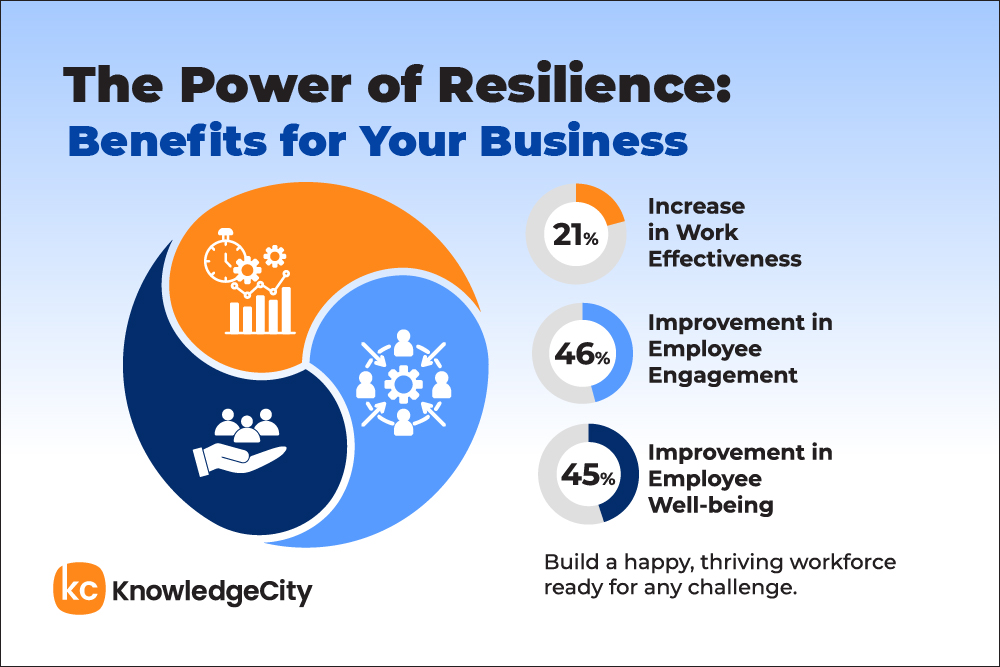In today’s demanding work environment, employees encounter a steady flow of challenges. From tight deadlines and heavy workloads to interpersonal conflicts and organizational change, these difficulties can impact mental and emotional well-being, resulting in disengagement, decreased productivity, and high turnover.

However, there’s good news. By nurturing resilience—the ability to rebound from setbacks and adapt to change—HR can provide employees with the tools they need to thrive. In this article, we’ll explore essential strategies HR can implement to cultivate a resilient workforce and support employee well-being.
What is Resilience in the Workplace?
Resilience acts as a bridge between the challenges we face and our overall well-being. It’s a key factor that allows us to navigate life’s uncertainties while maintaining a sense of comfort and staying engaged in our pursuits.
When employees are resilient, they possess the strength to bounce back from setbacks, navigate through difficult situations, and grow from adversity. This translates into the workplace where workers are better equipped to handle any stress or issues that will inevitably arise.
Resilient employees also maintain a more positive outlook, allowing them to stay committed to their work and feel a sense of accomplishment. This ability to handle difficult situations enhances an employee’s mental and emotional health while increasing their motivation, making them more committed and satisfied with their work.
In fact, a McKinsey & Company survey focused on employee experience found that taking care of one’s physical and mental health was associated with a 21% improvement in work effectiveness, a 46% improvement in employee engagement, and a 45% improvement in well-being.
By promoting resilience within teams, HR professionals can create a positive work environment where employees feel supported, empowered, and capable of overcoming obstacles.
The Importance of Resilience
A resiliency gap exists, according to a report from SAS which states that, “despite recognizing the critical role of resiliency, less than half of executives (47%) see their organization as resilient.”
Resilience is not about avoiding stress or challenges, but rather about being able to navigate through them and come out stronger on the other side. In the workplace, resilience is essential for employees to thrive and succeed, especially in times of uncertainty and change. The two key benefits of resilience in the workplace are:
- Employee Well-being
Resilience is closely linked to employee well-being. When employees are resilient, they are better equipped to handle stress and challenges, leading to improved mental and emotional health. This can reduce absenteeism, burnout, and turnover rates within the organization.
- Employee Engagement
Resilience also plays a significant role in employee engagement. When employees are resilient, they are more likely to feel motivated, engaged, and committed to their work. They are better able to handle setbacks and challenges, leading to increased productivity and job satisfaction.
Assessing the Needs of Employees
Assessing the needs of employees is important for HR professionals to understand how to support and promote resilience within their teams. By conducting assessments, HR can identify key areas where employees may require additional support or resources.
These assessments can help HR tailor its strategies and initiatives to meet the specific needs of the workforce, ultimately leading to a more resilient and engaged team. Here are some key methods HR can utilize to effectively assess employee needs:
-
- Formal Assessments:
- Surveys: Anonymous surveys allow employees to offer candid feedback on different facets of their work experience, such as workload, stress levels, training requirements, and overall satisfaction.
- Performance Reviews: When conducted regularly, performance reviews can be a valuable tool to assess individual needs and identify areas for development.
- Formal Assessments:
-
- Informal Assessments:
-
- Focus Groups: Gathering small groups of employees for open discussions can provide valuable insights into their needs and concerns. Focus groups create an environment where employees can feel comfortable sharing their perspectives freely.
- Exit Interviews: When employees leave the company, conducting exit interviews can reveal more about their reasons for departure. This can highlight potential issues within the organization that need to be addressed.
-
- Informal Assessments:
- Data Analysis:
-
- Reviewing HR Metrics: Metrics like absenteeism rates, employee turnover, and accident rates may highlight potential areas of employee well-being concern. This data can inform the development of focused interventions.
- Performance Management Data: Delving into performance data can uncover patterns indicating potential skill deficiencies or the necessity for further training in particular areas.
-
By utilizing diverse assessment methods and prioritizing employee welfare, HR departments can establish a work environment tailored to individual needs and cultivate a culture of engagement and development.
Steps for Building Resilience and Boosting Engagement
Step 1: Assessment and Understanding
- HR Takes the Lead: The HR department plays a pivotal role in assessing employee needs. This can involve conducting surveys, focus groups, and one-on-one meetings to understand current stress levels, sources of discouragement, and areas where support is needed.
- Identifying Strengths and Gaps: Analyze data from assessments to identify existing strengths within the workforce in terms of resilience and engagement. This will also reveal areas where targeted interventions can be implemented.
Step 2: Cultivating a Supportive Work Environment
- Open Communication Channels: Create an environment where employees feel empowered to express concerns and seek assistance. Holding regular meetings, utilizing anonymous surveys, and establishing transparent communication channels from leadership are effective methods to promote open dialogue.
- Work-Life Balance and Well-being Programs: Encourage a healthy work-life balance by offering flexible work arrangements, generous vacation policies, and access to mental health resources. Additionally, consider wellness programs that encourage physical activity, healthy eating, and stress management techniques.
Step 3: Building Individual and Collective Strength
- Invest in Learning and Development: Provide employees with the necessary skills and knowledge to excel in their roles. This instills confidence and a sense of control. Offer training programs focusing on stress management, problem-solving, communication, and emotional intelligence.
- Empowerment and Recognition: Grant employees ownership of their work and opportunities for growth within their teams. Recognize and celebrate achievements to build confidence and instill a sense of purpose.
Step 4: Leading by Example
- Strong Leadership Communication: Senior leadership establishes the organization’s tone. Leaders should exhibit empathy, effective communication skills, and exemplify resilient behaviors. Openly addressing challenges and handling them with composure builds trust and resilience across the workforce.
Step 5: Continuous Monitoring and Improvement
- Tracking Progress: Consistently evaluate the impact of implemented programs using surveys, focus groups, and HR data analysis. This enables adjustments and ensures that interventions remain aligned with employee needs.
- Adapting to Change: Work dynamics are always shifting; but by consistently evaluating requirements and adjusting programs, HR can guarantee that the workforce remains resilient and committed amidst change.
Building Resilience with KnowledgeCity
Resilience is essential for employees, and HR professionals have a responsibility to support and promote it within their organizations. By nurturing open communication, providing mental health resources, offering training, encouraging work-life balance, and acknowledging resilience, you can develop a resilient workforce capable of overcoming challenges and thriving. Request a demo from KnowledgeCity to learn more about supporting your employees. To learn more about supporting your employees, request a demo from KnowledgeCity today.
Subscribe to Our Newsletter
Join 80,000+ Fellow HR Professionals. Get expert recruiting and training tips straight
to your inbox, and become a better HR manager.

 KnowledgeCity
KnowledgeCity 











